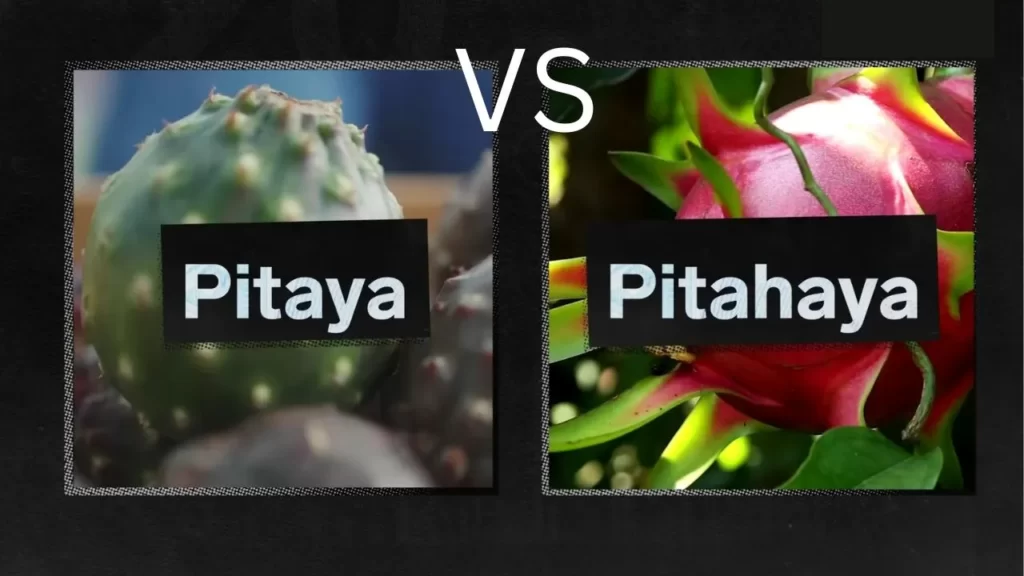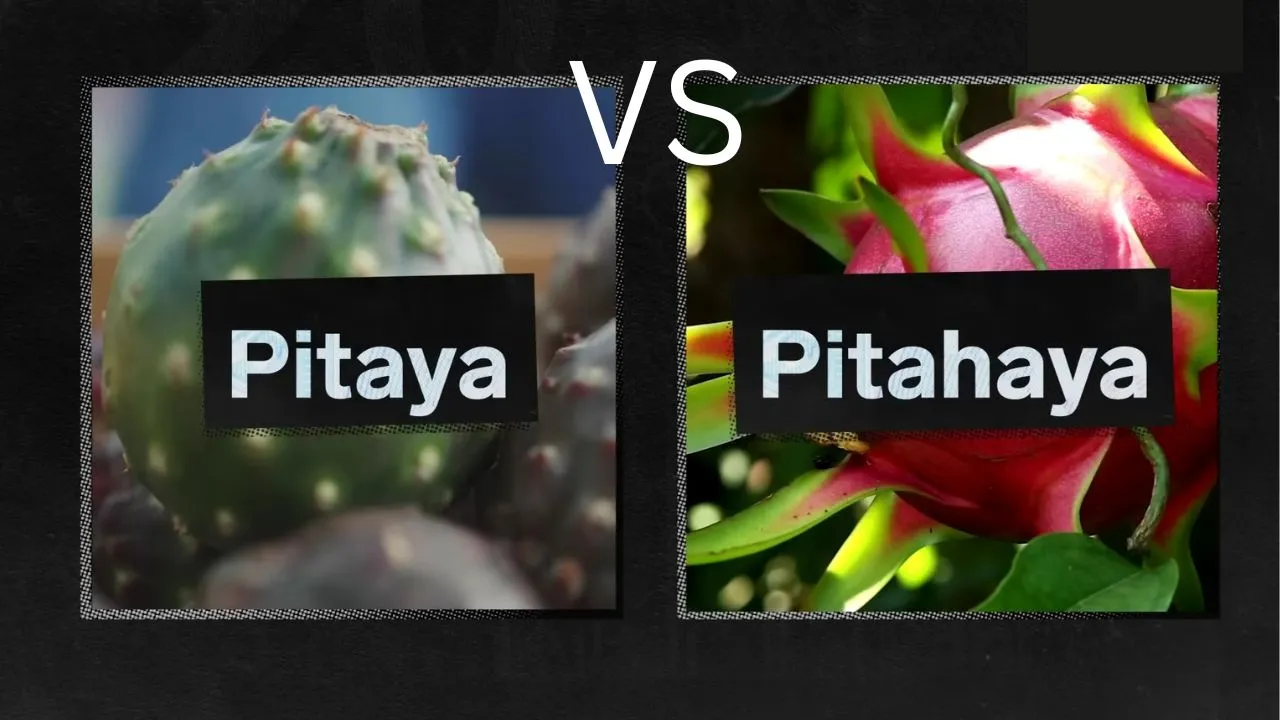“Mexican pitaya vs dragon fruit” is a common search topic among people who don’t know the difference between these healthy two fruits.
If you are looking for a new fruit to add to your diet. Mexican pitaya or dragon fruit may be the right choice for you.
In this blog post, we’ll look at the similarities and differences between these two fruits so that you can make an informed decision about which one is best for you.
We’ll also discuss the nutritional benefits and potential side effects of both fruits. By the end of this post, you’ll know everything you need to know about Mexican pitaya and dragon fruit!

Also Read:
- Pepino Melon: Side Effects, Benefits, How To Eat, Taste & All.
- Mexican Pitaya: Side Effects, Nutrition, Recipes, Taste & All.
- 17 Health Benefits of Mexican Pitaya.
- What Does Dragon Fruit Taste Like? Side Effects, Recipes & All.
Table of Contents
Mexican Pitaya Vs Dragon Fruit:
Introduction:
Mexican pitaya and dragon fruit are both fruits that are native to Central and South America.
They are both cactus fruits and have a similar appearance, but there are some key differences between the two.
- Mexican pitaya is a type of Hylocereus cactus that is native to Jalisco, Mexico. It has a bright red skin and a white flesh with black seeds. The flavor is mild and sweet, and the flesh is slightly crunchy. Mexican pitaya is a good source of vitamins C and A, as well as fiber.
- Dragon fruit is a type of Selenicereus cactus that is native to Southeast Asia. It can have red, white, or yellow skin, and the flesh can be white, pink, or yellow. The flavor is also mild and sweet, and the flesh is slightly crunchy. Dragon fruit is a good source of vitamins C and A, as well as fiber.
Look:
While the terms Mexican Pitaya and Dragon Fruit are often used interchangeably, there can be slight visual differences between them depending on regional variations and specific species.
However, it’s important to note that these differences are not consistent or definitive.
- Skin Color: Both Mexican Pitaya and Dragon Fruit can have a range of skin colors, including pink, yellow, and red. However, in some cases, the term “Mexican Pitaya” is used specifically for fruits with pink or red skin, while “Dragon Fruit” may be used for fruits with yellow or more vibrant red skin.
- Scale Appearance: The scales on the skin of Mexican Pitaya and Dragon Fruit can vary in shape and prominence. Some varieties of Dragon Fruit may have more prominent, elongated scales, giving them a slightly more pronounced and dragon-like appearance.
- Flesh Color: The flesh color of Mexican Pitaya and Dragon Fruit can be white, pink, or even red, depending on the species and variety. Generally, white-fleshed Dragon Fruit is more common, but pink and red-fleshed varieties are also found.
- Seed Color: The seeds in both Mexican Pitaya and Dragon Fruit are small and black. They are scattered throughout the flesh and are edible.
It’s important to remember that the visual differences between Mexican Pitaya and Dragon Fruit are not definitive, and the appearance of the fruit can vary significantly depending on the specific species, variety, and growing conditions.
Ultimately, whether referred to as Mexican Pitaya or Dragon Fruit, the overall experience and taste of the fruit are more similar than different.
Taste:
Mexican Pitaya and Dragon Fruit, which are often used interchangeably to refer to the same fruit, have a mild and subtly sweet taste.
However, there can be slight variations in flavor depending on the specific species, variety, and ripeness of the fruit.
Here are some common characteristics of their taste profiles:
Mexican Pitaya (Hylocereus undatus):
- The flesh of Mexican Pitaya is usually white or pink.
- The taste is often described as delicately sweet with hints of pear and kiwi.
- The flavor is mild and pleasant, with a refreshing and slightly tropical quality.
- Some varieties of Mexican Pitaya may have a subtly tangy undertone, adding a touch of brightness to the overall flavor.
Dragon Fruit (Hylocereus species):
- Dragon Fruit can have white, pink, or even red flesh, depending on the variety.
- The taste is generally mild and sweet, similar to a blend of kiwi and pear.
- The flavor is refreshing and subtly fruity, with a hint of floral notes.
- Some varieties of Dragon Fruit may have a slightly more pronounced sweetness compared to Mexican Pitaya.
It’s important to note that the taste experience can be subjective, and individual palates may perceive flavors differently.
Additionally, the overall flavor profile can be influenced by factors such as the fruit’s ripeness, growing conditions, and individual taste preferences.
Regardless of the minor variations, both Mexican Pitaya and Dragon Fruit offer a delightful and enjoyable eating experience.
Their mild, sweet taste makes them versatile fruits that can be enjoyed on their own or incorporated into various culinary creations.
Nutrition:
Here is a table of the nutritional difference between Mexican pitaya and dragon fruit (100g):
| Nutrient | Mexican Pitaya | Dragon Fruit |
|---|---|---|
| Calories | 50 | 50 |
| Protein | 1.4g | 1.3g |
| Fat | 0.1g | 0.1g |
| Carbohydrates | 12g | 11g |
| Fiber | 2.3g | 2.2g |
| Sugar | 8.5g | 8.3g |
| Vitamin C | 27mg | 22mg |
| Vitamin A | 100 IU | 80 IU |
| Calcium | 10mg | 8mg |
| Iron | 0.2mg | 0.1mg |
| Magnesium | 22mg | 20mg |
| Potassium | 170mg | 150mg |
As you can see, the nutritional difference between Mexican pitaya and dragon fruit is relatively minor.
Both fruits are good sources of vitamins C and A, as well as fiber. However, Mexican pitaya has slightly higher levels of vitamins C and A.
It is important to note that these are just the nutritional values for 100g of fruit.
The actual nutritional content of a fruit may vary depending on its size, variety, and ripeness.
Benefits:
Mexican Pitaya and Dragon Fruit, being the same fruit from the Hylocereus genus, share similar health benefits due to their comparable nutritional profiles.
Here are some potential benefits associated with consuming Mexican Pitaya and Dragon Fruit:
- Antioxidant Properties: Both fruits are rich in antioxidants, including vitamin C and other compounds such as betalains. Antioxidants help protect cells from damage caused by harmful free radicals, which may reduce the risk of chronic diseases and promote overall health.
- Immune Support: The high vitamin C content in Mexican Pitaya and Dragon Fruit can support immune function by promoting the production of white blood cells and enhancing the body’s defense against infections.
- Digestive Health: These fruits are a good source of dietary fiber, which aids in digestion, promotes bowel regularity, and supports a healthy digestive system.
- Hydration: Mexican Pitaya and Dragon Fruit have a high water content, contributing to hydration and supporting overall bodily functions.
- Nutrient Absorption: The presence of both soluble and insoluble fiber in these fruits can aid in nutrient absorption and promote a healthy gut environment.
- Heart Health: The low-fat content and high fiber content in Mexican Pitaya and Dragon Fruit can contribute to heart health by helping to maintain healthy cholesterol levels and supporting cardiovascular function.
- Eye Health: These fruits contain various nutrients, including vitamin C and antioxidants, that are beneficial for eye health and may help protect against age-related macular degeneration and other eye disorders.
It’s important to note that individual responses to food and health benefits may vary, and the overall impact of these fruits on health should be considered as part of a balanced diet and a healthy lifestyle.
Consulting with a healthcare professional or registered dietitian can provide personalized guidance on incorporating Mexican Pitaya and Dragon Fruit into a well-rounded diet.
How to eat:
Mexican Pitaya and Dragon Fruit, which are essentially the same fruit, can be enjoyed in similar ways.
Here are some common eating differences and methods for consuming Mexican Pitaya and Dragon Fruit:
- Fresh Consumption: The most straightforward way to enjoy Mexican Pitaya and Dragon Fruit is by eating them fresh. To do so, simply cut the fruit lengthwise and scoop out the flesh with a spoon. The flesh is typically soft and juicy, with a mild and refreshing flavor. The fruits can be eaten as is, without any additional preparation.
- Sliced or Cubed: Mexican Pitaya and Dragon Fruit can also be sliced or cubed. After cutting the fruit lengthwise, you can further slice the flesh into thin pieces or cube it into bite-sized chunks. This makes it easier to include the fruit in salads, fruit bowls, or other culinary creations.
- Smoothies and Juices: Both Mexican Pitaya and Dragon Fruit are popular ingredients for smoothies and juices. Blend the flesh with other fruits, such as bananas or berries, along with some liquid (like water, coconut water, or juice) to create a vibrant and nutritious smoothie. Alternatively, you can juice the fruits and enjoy their refreshing flavors in liquid form.
- Culinary Preparations: Mexican Pitaya and Dragon Fruit can be used in various culinary preparations. They can be incorporated into desserts, such as fruit tarts, sorbets, or popsicles. The fruits can also be added to fruit salads, salsa, or incorporated into savory dishes for a touch of sweetness and visual appeal.
- Dried or Freeze-Dried: While less common, Mexican Pitaya and Dragon Fruit can also be dried or freeze-dried. This process removes the moisture from the fruit, resulting in a different texture and concentrated flavor. Dried or freeze-dried Pitaya or Dragon Fruit can be enjoyed as a snack or used as a topping for yogurt, cereals, or baked goods.
Remember to wash the fruits thoroughly before consuming them, and consider experimenting with different preparations to find your preferred way of enjoying Mexican Pitaya and Dragon Fruit.
Side Effects:
Both Mexican Pitaya and Dragon Fruit are generally safe to consume for most individuals.
However, it’s important to note that individual sensitivities and allergies can vary.
Here are some considerations regarding potential side effects:
- Allergic Reactions: Although rare, some individuals may be allergic to Mexican Pitaya or Dragon Fruit. Allergic reactions can vary in severity and may include symptoms such as itching, hives, swelling, or difficulty breathing. If you have known allergies to other fruits or cacti, it’s advisable to exercise caution and consult with a healthcare professional before consuming these fruits.
- Digestive Issues: In some cases, consuming Mexican Pitaya or Dragon Fruit may cause mild digestive issues, such as bloating, gas, or diarrhea. This is more likely to occur if you consume the fruits in excessive amounts or if your digestive system is sensitive to dietary fiber. Moderation and gradually introducing these fruits into your diet can help minimize such issues.
- Oxalate Content: Mexican Pitaya and Dragon Fruit contain oxalates, which are naturally occurring compounds found in certain foods. High levels of oxalates can contribute to the formation of kidney stones in susceptible individuals. If you have a history of kidney stones or are at risk for them, it’s advisable to consult with a healthcare professional to determine the appropriate dietary choices for your specific situation.
- Pesticide Residues: Like any other fruit, Mexican Pitaya and Dragon Fruit may have pesticide residues if not grown organically or if not properly washed before consumption. It’s recommended to wash the fruit thoroughly before cutting and consuming it, or consider purchasing organic options to minimize potential exposure to pesticides.
It’s important to listen to your body and monitor any potential adverse reactions when introducing new foods into your diet.
If you experience any concerning symptoms or have specific health concerns, it’s always best to consult with a healthcare professional for personalized advice.
How to choose:
When it comes to choosing between Mexican Pitaya and Dragon Fruit, there are a few factors you can consider:
- Availability: Depending on your location and the season, one of the fruits may be more readily available than the other. Dragon Fruit is generally more widely available in many parts of the world due to its increasing popularity, while Mexican Pitaya might be more common in specific regions or during certain times of the year.
- Appearance and Variety: Both Mexican Pitaya and Dragon Fruit come in different varieties, each with its own appearance. Consider the visual appeal you’re looking for. Dragon Fruit can have vibrant pink, yellow, or red skin with green scales, while Mexican Pitaya may have pink or red skin with green scales. You might have a preference for a specific color or aesthetic.
- Flesh Color: The color of the flesh can vary between varieties of Mexican Pitaya and Dragon Fruit. Dragon Fruit commonly has white or pink flesh, while Mexican Pitaya can have white or pink flesh as well, but some varieties may have red or purple flesh. If you have a preference for a particular flesh color, that can influence your choice.
- Taste: Although both fruits have a similar taste profile—mildly sweet and refreshing—some individuals may detect subtle differences in flavor. If you have tried both fruits before, you can choose based on your personal preference for taste. However, if you haven’t tried them, it’s worth giving them both a taste test to see which one appeals to you more.
- Culinary Uses: Consider the culinary applications you have in mind. Both Mexican Pitaya and Dragon Fruit can be enjoyed fresh, used in smoothies, incorporated into salads or desserts, and more. However, the specific flavor, texture, and color of the fruit you choose may be better suited for certain recipes or preparations.
Ultimately, the choice between Mexican Pitaya and Dragon Fruit comes down to personal preference, availability, and the specific qualities you’re looking for in terms of appearance, taste, and culinary uses.
It can be an enjoyable experience to explore and try both fruits to see which one resonates with you the most.
How to store:
Both Mexican pitaya and dragon fruit can be stored in the refrigerator for up to a week. They can also be frozen for longer storage.
Overall, both Mexican pitaya and dragon fruit are nutritious additions to a balanced diet.
Which one you choose ultimately comes down to personal preference in taste and appearance. Try them both and see which one you like best!
Related FAQs:
No, they are different varieties of the cactus family with variations in taste, appearance, and nutrition. However, they are often grouped together as “dragon fruit.”
Yes, the skin is edible and can be eaten raw or cooked. It is best to wash the skin before consuming.
Eating dragon fruit can help promote weight loss due to its low-calorie and high-fiber content. It also has antioxidant properties that can aid in overall health and digestion.
However, it is important to remember that consuming any food in moderation is key to maintaining a healthy weight.
Yes, Mexican pitaya can be stored in the freezer for longer shelf life. It can also be thawed and used in smoothies or cooked into desserts.
Yes, dragon fruit can be cooked into dishes such as pies or baked goods. It can also be added to salads or used as a topping for yogurts and oatmeal. Experiment with incorporating dragon fruit into your cooking!
This ultimately comes down to personal preference in taste and appearance. Both Mexican pitaya and dragon fruit are nutritious additions to a balanced diet. Try both and see which one you like best!
Conclusion
Mexican Pitaya and Dragon Fruit are names often used interchangeably for the same fruit from the Hylocereus genus.
While there may be minor differences in appearance and regional usage of the terms, the overall taste, nutritional benefits, and culinary uses of both fruits are similar.
They are visually stunning fruits with vibrant colors and a mild, refreshing flavor. Both Mexican Pitaya and Dragon Fruit offer a range of health benefits, including antioxidants, fiber, and essential vitamins.
Whether you choose Mexican Pitaya or Dragon Fruit, or simply opt for the one that is more readily available in your region, you can enjoy a delightful tropical experience and add a touch of exotic allure to your meals and snacks.

